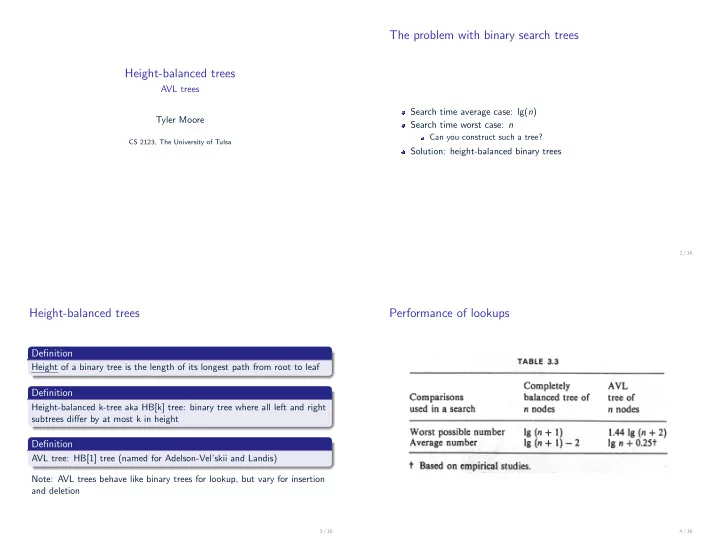

The problem with binary search trees Height-balanced trees AVL trees Search time average case: lg( n ) Tyler Moore Search time worst case: n Can you construct such a tree? CS 2123, The University of Tulsa Solution: height-balanced binary trees 2 / 16 Height-balanced trees Performance of lookups Definition Height of a binary tree is the length of its longest path from root to leaf Definition Height-balanced k-tree aka HB[k] tree: binary tree where all left and right subtrees differ by at most k in height Definition AVL tree: HB[1] tree (named for Adelson-Vel’skii and Landis) Note: AVL trees behave like binary trees for lookup, but vary for insertion and deletion 3 / 16 4 / 16
Height-balanced trees Spot the AVL tree Definition Balance Factor aka BF(node) = Height(left subtree) - Height(right subtree) BF(node) = 1 = ⇒ Left-heavy tree BF(node) = -1 = ⇒ Right-heavy tree BF(node) = 0 = ⇒ Balanced Tree 5 / 16 6 / 16 AVL insert rules Insertion Case 1 1 Find position to insert node as in a BST. Identify the deepest level node along the path that has BF 1 or -1 prior to insertion. Label this node the pivot. 2 From the pivot node down, recompute balance factors. 3 Check whether any node’s balance factor switched from 1 to 2 or -1 to -2. 4 If balance factor did change to -2 or 2, then a rebalancing at the pivot is needed. T 1 < A < T 2 < B (root) < T 3 T 1 < A (root) < T 2 < B < T 3 → 7 / 16 8 / 16
Insertion Case 2 Insertion Case 3 T 1 < A (root) < T 2 < B < T 3 T 1 < A < T 2 < B (root) < T 3 → T 1 < A < T 2 < B < T 3 < C (root) < T 4 → T 1 < A < T 2 < B (root) < T 3 < T 4 9 / 16 10 / 16 Insertion Case 4 AVL example Insert in sequence 20,10,40,50,90,30,60,70,5,4,80 T 1 < A (root) < T 2 < B < T 3 < C < T 4 → T 1 < A < T 2 < B (root) < T 3 < T 4 11 / 16 12 / 16
In-class exercises Analysis of AVL trees How often do we need to rotate? Cost of an insert that requires rotation Worst-case cost of a search 13 / 16 14 / 16 Analysis of AVL trees Concluding thoughts on AVL trees 1 Insertions require at most one rotation and therefore do not affect lookup costs, but deletions require up to lg( n ) rotations What is the additional cost of an AVL rotation 2 On average, 0.465 rotations required per insertion visiting 2.78 nodes Locate pivot (additional 1 unit cost per level): O ( lg ( n )) 1 to restore balance Cost of rotation: O (1) 2 3 52% of the time: no rebalancing, single rotation 23.3% , 23.2% Conclusion: does not affect the order of the search cost, remains double rotation O ( lg ( n )) worst case 4 AVL preferred over other balanced binary trees if only insertion and lookup operations required; if deletion required should consider other options 15 / 16 16 / 16
Recommend
More recommend